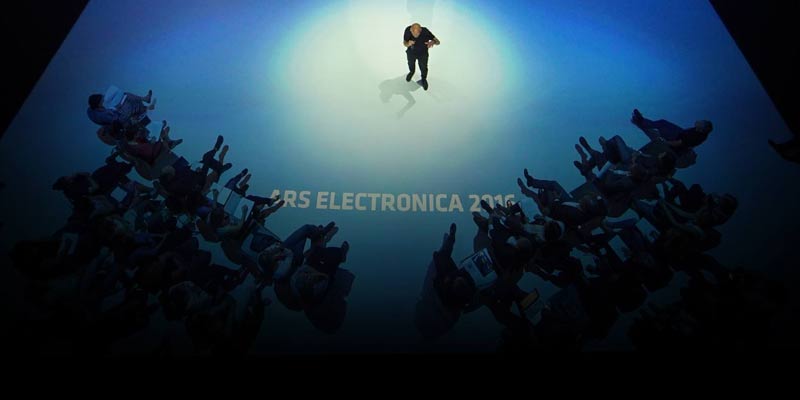Ars Electronica Center and Linz Art University proudly present
A New Exhibition: TIME OUT .06
press release: A New Exhibition: TIME OUT .06 / PDF
(Linz, June 8, 2016) The latest exhibition in the TIME OUT series produced jointly by the Ars Electronica Center and Linz Art University’s Time-based and Interactive Media program once again showcases the outstanding work being done by young media artists in Linz. “TIME OUT .06” features interactive media art installations featuring a cross-section of the artistic forms of expression that have emerged throughout the 10-year history of our program,” stated director Gerhard Funk. “Microorganisms that influence texts output on a typewriter, the illusion of a mirror, an LED light storm—time and time again, it’s fascinating to see what young media artists are into,” said Ars Electronica Artistic Director Gerfried Stocker.
TIME OUT .06: The Projects
CRACKS / Sarah Youssef (AT)
Sarah Youssef’s CRACKS is about violent sex crimes committed against women in public spaces. The centerpiece is an audio installation in which nine interviews with staff members of an organization providing counseling to female rape victims are played from nine objects created out of plaster—negative casts of cracks in the pavement that refer to important locations in a woman’s life. In each interview, the social workers explain essential terminology related to the subject of sexual violence. The aim is to create awareness of these terms and to enlighten people about sex crimes.
In Vitro Typewriter / Simon Christoph Krenn (AT)
Simon Christoph Krenn’s work consists of an old mechanical typewriter that’s connected via an Arduino interface to two Petri dishes containing agar culture medium in which colonies of microorganisms that were introduced by hand contact are growing. The growth of these colonies influences a text that is automatically written on the typewriter by an algorithm. The faster the microorganisms proliferate and mutate, the more radically a historical scientific text about evolutionary biology and the principle of natural selection is modified, and the increasingly fragmentary text compositions are output by the typewriter. “In Vitro Typewriter” is based upon a hypothesis put forth by Czech media philosopher Vilém Flusser: “If memory is defined simply as information storage, then we find memories all over nature. They float like islands within the general stream towards entropy, islands that preserve information for a time before they dissolve. (…) The Second Principle of Thermodynamics (…) states that information contained in nature tends to be forgotten.” (Flusser: On Memory, 1990)
mirror_0.2 / Gregor Woschitz (AT)
Gregor Woschitz’s “mirror_0.2” is an interactive installation that replaces the installation visitor’s reflection with that of the artist. A Kinect installed above the monitor screen registers the position and facial expression of the person standing in front of it, so instead of seeing their own reflection in the mirror, installation visitors see the artist imitating them. For this installation, the artist shot approximately 100,000 images of himself with different facial expressions, his head tilted in various directions, and in diverse postures. Software determines which of these photos most closely resembles the appearance of the person standing in front of the mirror and displays that particular photo on the monitor screen. The background is a 3-D scan that resembles the background of the actual space behind the visitor. Plus, the virtual space is slightly distorted in a realistic way to strengthen the illusion of a mirror image.
Scratching Wounds / Karol Kensy (AT)
A record album created with a Ms. Pinky timecode vinyl system, scratching, and critique on testing products on animals are what have gone into Karol Kensy’s work “Scratching Wounds.” As soon as the turntable starts to spin the record album, advertisements for various pharmaceuticals, cosmetics and detergents are projected onto the wall of the installation space. And as soon as an installation visitor “scratches” the record—i.e. moves his/her hand back and forth across its surface—video material documenting the products’ ingredients being tested on animals is mixed into the advertising. Thus, in a metaphorical sense, one is “scratching” on wounds. Karol Kensy’s aim in creating this work is to show that animal testing continues to be a common practice in the pharmaceutical industry. The artist has performed painstaking research on each advertisement, so that he can prove exactly which ingredients that go into these pharmaceutical products have been subjected to testing on animals.
Lightstorm / Katharina Gruber (AT), Gregor Woschitz (AT), Laurin Döpfner (AT)
The “Lightstorm”—two meters high, three meters in diameter, and spinning at a rate of 35 km/h—is an oversized, rotating tube with LED strips embedded all around its outer surface. While the cylinder is in motion, the installation visitors’ visual faculties interpret the rapidly blinking LEDs as a drawing in midair. Impressions of pulsating images in space occur on the retina. The artists intend “Lightstorm” to symbolize the individual amidst the maelstrom of big-city life. The 21st-century cityscape is characterized by the proliferation of light sources, which exert a powerful influence on human beings and their biorhythms.
http://www.flickr.com/photos/arselectronica/27524965285/Lightstorm / Fotocredit: Magdalena Leitner / Printversion / Album
http://www.flickr.com/photos/arselectronica/27524964125/Cracks / Fotocredit: Magdalena Leitner / Printversion / Album
http://www.flickr.com/photos/arselectronica/27452903981/In Vitro Typewriter / Fotocredit: Magdalena Leitner/ Printversion / Album
http://www.flickr.com/photos/arselectronica/27452903051/Scratching Wounds / Fotocredit: Magdalena Leitner / Printversion / Album

